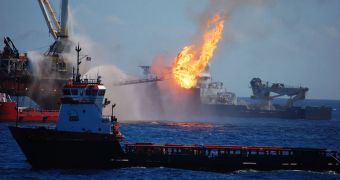After the Deepwater Horizon oil rig exploded on April 20, and sank into the Gulf of Mexico two days later, as much as 1 in every 13 barrels of spilled oil was eventually turned into particles that made their way into the atmosphere, rather than being deposited in the sea.
The conclusion belongs to a new study, which was conducted by the Earth System Research Laboratory (ESRL) and the Cooperative Institute for Research in Environmental Science (CIRES), which both belong to the US National Oceanic and Atmospheric Administration (NOAA).
According to the team, the spill – which occurred from April 20 up until July 15 – produced just as much air pollution as a large city. Details of the analysis are published in a December 19 special issue of the esteemed journal Proceedings of the National Academy of Sciences (PNAS).
During their investigation, researchers only analyzed the amounts of ozone and particulate matter that the spill put into the atmosphere, since these two chemicals have the most severe effects on human health. The oil spill produced countless particles that could have easily deposited inside lungs.
“We could see the sooty black clouds from the burning oil, but there’s more to this than meets the eye. Our instruments detected a much more massive atmospheric plume of almost invisible small organic particles and pollutant gases downwind of the oil spill site,” Ann M. Middlebrook explains.
The expert is the lead author of the new study, and also a research scientist at the NOAA ESRL Chemical Sciences Division (CSD). She explains that the mass of the organic particles released in the air during the spill is ten times bigger than the mass of soot produced during the controlled burns.
These particles came together in an atmospheric plume that grew to be about 30 kilometers (18.5 miles) wide when it reached the coastline. As they interacted with nitrogen in the air, the particles triggers ozone pollution.
“The levels of ozone were similar to what occurs in large urban areas. During the oil spill, it was like having a large city’s worth of pollution appear out in the middle of the Gulf of Mexico,” NOAA ESRL/CSD scientist and study coauthor Daniel M. Murphy explains.
“It was fortunate that the effects on air quality of the Deepwater Horizon oil spill were limited in scope. Our findings show that an oil spill closer to populated areas, or in shallower waters, could have a larger effect,” Middlebrook concludes.

 14 DAY TRIAL //
14 DAY TRIAL //